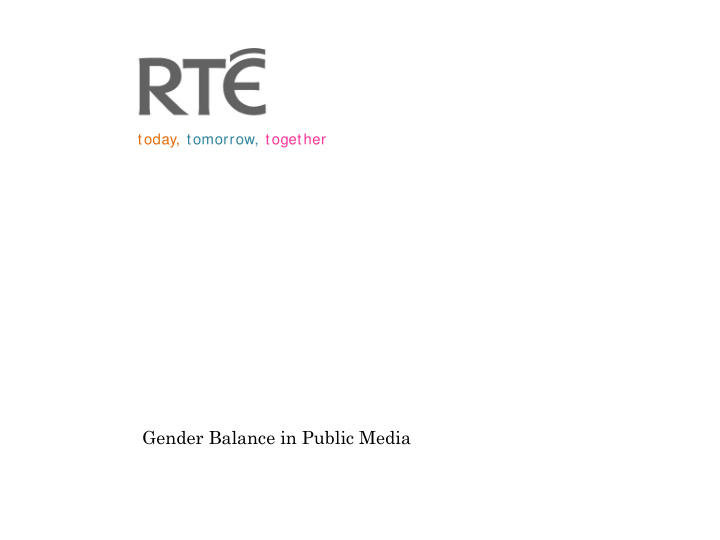



t oday, tomorrow, together Gender Balance in Public Media
RTÉ is Ireland’s National Public Service multi-media organisation. The radio service began on 1 January 1926, while television broadcasts began on 31 December 1961. RTÉ is therefore one of the oldest continuously operating public service broadcasters in the world. Opening night of RTÉ Television, 1961
Pictures do tell the story of the historic position of women in higher management roles in RTÉ. The below image, from 2001, features DGs and former Chairpersons of RTÉ – there had been only one woman up to that time. Similar to the Pubic Service, women had to resign on marriage, right up to 1973. RTÉ former DG’s and chairpersons, 2001
The first female newsreader on RTÉ Television, Geraldine McInerney, was appoint ed in 1974. This was considered quite revolutionary at the time. Female newsreaders were usually considered “too light” to be used for hard news. Most of RTÉ’s current newscasters, who are also journalists, are women.
In the 80’s new programmes on radio and television featured women up-front. Women Today on radio was produced by Clare Duignan, who eventually became Managing Director, Radio, after a long career in RTÉ Television, where she was Director of Programmes. The Women Talking series on television was radical for its day, in that women went on the national airwaves to talk about their most personal experiences and thoughts. One of the producers was Nuala O’Faolain, who later became a celebrated writer and commentator. Women Today on RTÉ Radio Women Talking on RTÉ Television
The WADE Project in the early 80’s was funded by the Government. The project had two objectives: • creating a directory so that more women would be used on-air (a new group of women with specialist knowledge who are 'broadcast ready’). • develop strategies for career development (to enable women employees to attain senior positions in RTÉ).
Administration Grades Results from WADE showed that anomalies existed in salary scales in the 1980s – women were well In 2003, 83 % were women represented as part of the workforce, but as grades got higher and salaries In 2013, 80% were women increased, numbers of women went down. Today, of RTE's 1,858 employees, almost half are women. There is indication of considerable improvement on the above stats, as more women now enter middle or senior management. While not equal in numbers, there is greater representation at management level. Management Grades In 2013, 42% of managers are women; 58% are men. Men continue to outnumber women in the higher-paid categories.
Up to last week, there were three women on the RTÉ executive board – Managing Directors of Radio, Digital and CFO. This was the highest-ever representation of women on the board, and improving this representation remains an objective. Today women account for 48pc of all staff members in RTÉ and contribute at all levels of the organisation, in a broad diversity of roles.
Current Policy Today, RTÉ is an equal-opportunities employer and women can, and have, attained high-level appointments. RTÉ Sport increased the number of female front-of- camera and radio. Claire Mc Namara and Tracy Piggott were joined by Jaqui Hurley, Evanne Ni Chuillin, Siobhan Madigan and Joanne Cantwell. RTÉ has also looked to develop new female analysts for women’s football, camogie and athletics. RTÉ Sport also has a high proportion of female editors and managers. Cliona O’Leary is Deputy Head of Sport, the highest position a woman has ever attained in RTÉ Sport Women on Air A new survey conducted by the National Women’s Council of Ireland shows that less than one quarter of voices in radio news and current affairs broadcasting are women. RTÉ recently partnered with the Women on Air group, and co-hosted a special seminar day which focused on strategies to improve representation of female commentators on air. The bespoke training day facilitated high-level female professionals across a diverse range of specialties, such as science, politics, law and industry. RTÉ will continue to engage on this important issue.
In 2013 women are prominent in RTÉ’s flagship morning current affairs programmes, on Morning Ireland on RTÉ Radio 1, and Morning Edition on RTÉ One, both in-front of and behind- the-scenes. RTÉ now has women represent ed at senior levels across all areas of output, both on-air and in senior editorial roles in TV News, Arts & Drama, and Music. The majority of producers in charge on the RTÉ Radio 1 peaktime schedule are women.
Gender Break Down Journalists Journalists 45% = Female • Female Journalists Male Journalists 55% = Male • Presenters 44.5%= Female • Presenters 54.5%= Male • Female Presenters Male Presenters
S upporting Equality within the Workplace • Flexible working/job sharing and term time working, where this can be supported by the business. • Leave of absence for a period of 12 months. • Full pay while on Maternity Leave (this is over and above the statutory payment). • The provision of an award-winning, on-site, indirectly subsidised crèche in a modern purpose-designed building.
Recommend
More recommend